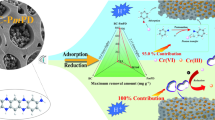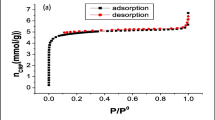Abstract
An amino-functionalized grooved polyacrylonitrile nanofiber mat was modified by both functional groups and in terms of surface morphology. The mat is shown to represent a viable adsorbent for solid-phase extraction of six priority phenolic pollutants and three phenolic xenoestrogens (phenol, 3-methoxyphenol, 4-nitrophenol, 2,4-dichlorophenol, 2,4,6-trichlorophenol, pentachlorophenol, 4-tert-octylphenol, 4-nonylphenol and bisphenol A) from environmental water samples. Under optimized conditions, the analytes were completely extracted from 90 mL of water sample by using only 9 mg of the mat material. Following elution with an ammoniacal methanol-acetone mixture, the eluent was directly submitted to UPLC-MS/MS or HPLC with DAD detection. Satisfied linearity in range of 50 pg·mL−1 to 100 ng·mL−1 was achieved. The detection limits ranged from 4 to 60 pg·mL−1 which revealed the excellent sensitivity of the method in comparison to standardized and other techniques. The recoveries ranged from 82.4% to 111.4%, with the relative standard deviations of 4.0% to 11.4% (for n = 6). The method was applied to the determination of nine phenolic pollutants in water samples collected from sixteen inflow rivers and six Taihu Lake regions.

Amino-functionalized grooved nanofibers mat-based solid-phase extraction for simultaneous determination of nine phenolic pollutants in environmental water






Similar content being viewed by others
References
Zhu J, Wang Y, Zeng L (2016) An approach to determination of phenolic compounds in seawater using SPME-GC-MS based on SWCNTs coating. J Ocean Univ China 15:655–659
Babaee S, Daneshfar A (2016) Extraction of phenolic compounds from water samples by dispersive micro-solid-phase extraction. J Sep Sci 39:2508–2516
EPA Method 604, Phenols, in Federal Register, October 26, 1984, Environmental Protection Agency, Part VIII, 40 CFR Part 136, 58–66
EPA Method 625, Base/Neutrals and Acids, in Federal Register, October 26, 1984, Environmental Protection Agency, Part VIII, 40 CFR Part 136, 153–174
Zhou WM, Fu DQ, Sun ZG (1991) National environmental priority control pollutants. Res Environ Sci 4:9–12
National Standards of the People's Republic of China, GB 3838–2002, Environmental Quality Standards for Surface Water. State Environmental Protection Agency (SEPA)
Song HW, Wang DH, Xu X, Wang HL, Chen XC, Luo Q, Wang ZJ, Du YX (2014) The characteristics of concentration distribution of 14 phenolic compounds in 24 typical drinking water source of our country. J Environ Sci (China) 2:355–362
Zhao JL, Ying GG, Wang L, Yang JF, Yang XB, Yang LH, Li X (2009) Determination of phenolic endocrine disrupting chemicals and acidic pharmaceuticals in surface water of the pearl rivers in South China by gas chromatography-negative chemical ionization-mass spectrometry. Sci Total Environ 407:962–974
Martin J, Camacho-Munoz D, Santos JL, Aparicio I, Alonso E (2014) Determination of emerging and priority industrial pollutants in surface water and wastewater by liquid chromatography-negative electrospray ionization tandem mass spectrometry. Anal Bioanal Chem 406:3709–3716
Tyler CR, Jobling S, Sumpter JP (1998) Endocrine disruption in wildlife: a critical review of the evidence. Crit Rev Toxicol 28:319–361
Hyötyläinen T (2009) Critical evaluation of sample pretreatment techniques. Anal Bioanal Chem 394:743–758
Chen Y, Guo ZP, Wang XY, Qiu CG (2008) Sample preparation. J Chromatogr A 1184:191–219
Bagheri H, Mohammadi A (2003) Pyrrole-based conductive polymer as the solid-phase extraction medium for the preconcentration of environmental pollutants in water samples followed by gas chromatography with flame ionization and mass spectrometry detection. J Chromatogr A 1015:23–30
Chigome S, Torto N (2011) A review of opportunities for electrospun nanofibers in analytical chemistry. Anal Chim Acta 706:25–36
Chigome S, Torto N (2012) Electrospun nanofiber-based solid-phase extraction. Trends Anal Chem 38:21–31
Qi FF, Qian LL, Liu JJ, Li XQ, Lu LG, Xu Q (2016) A high-throughput nanofibers mat-based micro-solid phase extraction for the determination of cationic dyes in wastewater. J Chromatogr A 1460:24–32
Li XQ, Liu JJ, Qi FF, Yang BY, Tian T, Xu Q (2016) Solid phase extraction technique based on electrospun Nanofibrous. Chin J Anal Chem 44:474–481
Yang BY, Qi FF, Li XQ, Liu JJ, Rong F, Xu Q (2015) Application of Nylon6/Polypyrrole core-shell nanofibres mat as solid-phase extraction adsorbent for the determination of atrazine in environmental water samples. Int J Environ Anal Chem 95:1112–1123
Qi FF, Li XQ, Yang BY, Rong F, Xu Q (2015) Disks solid phase extraction based polypyrrole functionalized core-shell nanofibers mat. Talanta 144:129–135
Li XQ, Qi FF, Zhou FQ, Yang BY, Gao HT, Rong F, Xu Q (2015) Novel sample preparation technique based on functional nanofiber mat for sensitive and precise determination of phenolic xenoestrogens in environmental water. Anal Methods 7:5557–5564
Xu Q, Wu SY, Wang M, Yin XY, Wen ZY, Ge WN, Gu ZZ (2010) Electrospun Nylon6 Nanofibrous membrane as SPE adsorbent for the enrichment and determination of three estrogens in environmental water samples. Chromatographia 71:487–492
Fontanals N, Marce RM, Borrull F (2007) New materials in sorptive extraction techniques for polar compounds. J Chromatogr A 1152:14–31
Xu Q, Wu SY, Wang M, Yin XY, Wen ZY, Ge WN, Gu ZZ (2010) Electrospun Nylon6 Nanofibrous membrane as SPE adsorbent for the enrichment and determination of three estrogens in environmental water samples. Chromatographia 71:487–492
Tian T, Deng JJ, Xie ZY, Zhao YJ, Feng ZQ, Kang XJ, Gu ZZ (2012) Polypyrrole hollow fiber for solid phase extraction. Analyst 137:1846–1852
Zhang YY, Kang XJ, Chen LQ, Pan C, Yao YF, Gu ZZ (2008) Fiber-packed SPE tips based on electrospun fibers. Anal Bioanal Chem 391:2189–2197
Liang Y, Wang BY (2011) The determination of trace phenols in water by HPLC. J Anhui Agric Sci 26: 16076-16077+16079
Su YL, Fang L (2004) The determination of 12 phenolic compounds in water by SPE-HPLC. Modern Scientific Instruments 4:55–57
Bagheri H, Mohammadi A, Salemi A (2004) On-line trace enrichment of phenolic compounds from water using a pyrrole-based polymer as the solid-phase extraction sorbent coupled with high-performance liquid chromatography. Anal Chim Acta 513:445–449
Lee SK (2010) On-line SPE-HPLC method using alumina filtering to selectively extract phenolic compounds from environmental water. B Kor Chem Soc 31:3755–3759
Lopez-Roldan P, De Alda MJL, Barcelo D (2004) Simultaneous determination of selected endocrine disrupters (pesticides, phenols and phthalates) in water by in-field solid-phase extraction (SPE) using the prototype PROFEXS followed by on-line SPE (PROSPEKT) and analysis by liquid chromatography-atmospheric pressure chemical ionisation-mass spectrometry. Anal Bioanal Chem 378:599–609
Noestheden M, Noot D, Hindle R (2012) Fast, extraction-free analysis of chlorinated phenols in well water by high-performance liquid chromatography-tandem mass spectrometry. J Chromatogr A 1263:68–73
Hong AH, Yin PH, Liang ZH (2010) The determination of pentachlorophenol in drinking water by HPLC-MS/MS. Ecol Environ 1:69–71
Acknowledgements
This work was supported by the National Natural Science Foundation of China (Project No. 81172721, 81473019), and Suzhou Nano research Special Plan (Project No. ZXG2013026).
Author information
Authors and Affiliations
Corresponding author
Ethics declarations
The author(s) declare that they have no competing interests.
Electronic supplementary material
ESM 1
(DOCX 1.03 mb)
Rights and permissions
About this article
Cite this article
Qian, L., Li, X., Qi, F. et al. An amino-functionalized grooved nanofiber mat for solid-phase extraction of phenolic pollutants. Microchim Acta 184, 2861–2870 (2017). https://doi.org/10.1007/s00604-017-2313-1
Received:
Accepted:
Published:
Issue Date:
DOI: https://doi.org/10.1007/s00604-017-2313-1




